14mm: the comparison of 3 UWA: Samyang XP vs Venus Laowa
Samyang 14mm XP vs Venus Laowa 15mm Zero-D
For a landscape photographer, a ultra wide angle lens is nearly a must-to-have. Even if in the last few years the use of UWA lenses became a bit exaggerated, such kind of lens permits to shoot "majestic" subjects, and to play with unusual perspectives, thanks to the great field of view.
On the other side, an UWA is not an easy lens and it takes a good practice to master it: iyou must pay extreme attention to the composition, because it is very easy to put too many things into the frame, loosing the real subject.
But at the same time there are many situations in which it is (more or less) mandatory to use an UWA lens: for example, when we want to shoot a magnificent starry sky, or to get all the milky way arch. Or again, if we want to exploit different and unusual persectives and point of view..
In all these cases, a good UWA lens could make a huge difference (if we know how to use it).
The reference lens of the UWA
It is difficult not to find the very famous Samyang 14mm f:2.8 in the equipment of a landscape photographer: first of all, because of the price! It is very difficult to find a better lens in the same price range (around 300 bucks). Moreover, the little Sammy is very very popular between astrophotographers: the ultra wide angle, the good aperture (f:2.8) and a very little coma, make this lens an ideal choice for the ones who want to start with astrophotography. And even the more experienced astroshooters are very happy about it: take a look at the great guide from Lonely Speck, and you will understand why.
So... why do we have to look for another UWA lens, if this little (cheap) guy is so good?! Well... because it is good, but not perfect! First, it is not possible to use square filters on it (ok, it is not 100% true: Haida and few other brands have a 150mm filter holder that could be used on the little Sammy. But it is quite expensive, both the holder and the 150x150mm filters). Second point: the overall image quality is good, but at the corners the images are not so nice (great distortion, less sharpness, strong vignetting). Third, the distortion of Samyang 14mm f:2.8 is really strong: the effect could be not so bad, but it makes really difficult to stitch together multiple shots to create panorama.
The competitors
There are many good UWA lenses already on the market (Nikon and Canon produce great gear), but I decided to focus my attention on two new lenses, that generated a lot of hype: Samyang 14mm XP f:2.4 and Venus Laowa 15mm f:2 FE Zero-D.
Venus Laowa 15mm f/2 FE Zero-d
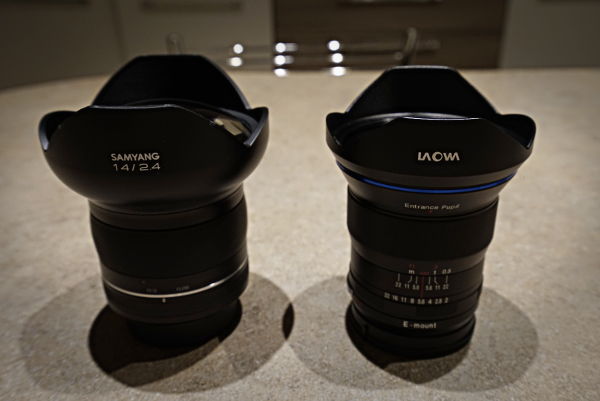
This lens created a lot of expectation when announced on the market: the great aperture, as well as the Zero Distortion feature, make this lens a perfect choice for landscapes, architectural, night photography, but even street. One thing is sure: when you handle this lens, you immediately have a great sense of sturdiness and precision. Focus and aperture rings are precise, smooth, with no loose movements. It is like to stare in front of an old-school lens, but with a nice design. The hood is made by metal (not plastic), and there is a switch to de-click the aperture ring (useful for videos). The lens is manual focus only.
The Venus Laowa comes in Sony FE mount only, and for Sony Alpha owners it is a great news! Yes, finally we have a dedicate lenses line, designed to exploit the great advantages of the mirrorless geometry. Yes, on the market we can find other lenses with FE mounts, but many ones are simply the same lens, with an adapter ring "incorporated". So they are huge. The Venus Laowa, when mounted on the Sony Alpha, is simply perfect. Not too big, not too heavy... perfect.
Samyang 14mm XP f:2.4
Samyang, as we used to know, seems that does not exist anymore. They became famous for building good manual lenses with affordable prices; now seems that they went in a totally different direction: the new products follow two line of business, AF (autofocus lenses) and XP (premium, ultra sharp lenses). Of course, the prices are not so low anymore.
To be really honest, I started this test very disappointed with Samyang: in the last months I tested about 8 lenses from this brand, and I had to send them all back due to poor quality. One of them (24mm f:1.4) was decentered: images were in focus only on a side of the frame... the opposite side was out of focus. Then I tested 7 copies of 20mm f:1.8: all of them was poorly built, and it was not possible for me to correctly focus at infinity (at least with my Sony a7R).
So, when I had the chance to test the XP family, I was very skeptical: the specs from the manufacturer were impressive, but.. who knows!
I really have to say thank to Samyang Italia and Giordano Innovation for the chance they gave me to test the lens: I tried to take it with me during my Elba photo adventure, but due to a late shipping, I was not able and I had to test it at home. Great chance anyway!
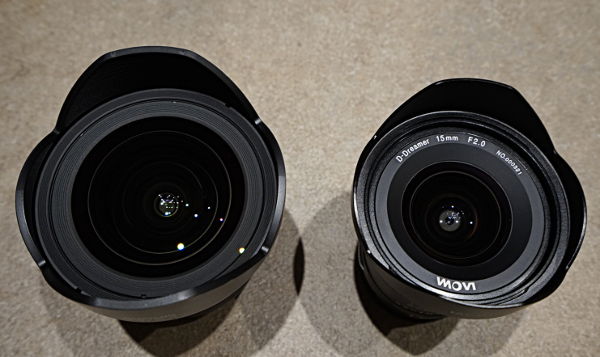
Speaking about the lens, lot of things were already told on the internet: big (huge, maybe), with a really modern look in the hood and in the focus ring. The lens seems to be "certified" for 50MP sensors. The weight is quite impressive, and if you look at it near the Venus Laowa, seems to stare at Goliath against David.
The focus ring itself is the thing that impressed me more: it has a very very long excursion, so the focusing is very precise. The copy I got was a Nikon mount, so I had to use a ring adapter to mount it on the Sony a7R. Forgot to mention that, even in this case, the lens is manual focus only.
Fist impression
The first impression of these two lenses is very straight-forward: a modern beast against a good lens. But the first impression is not always correct. For the "specs guys", here a brief comparison
| Samyang 14mm XP | Venus Laowa 15mm Zero-D | |
| Max Aperture | f:2.4 | f:2 |
| Structure | 18 elements in 14 groups | 12 elements in 9 groups |
| Filter Thread | ---- | 72mm |
| Angle of View | 114,1° | 110° |
| Length | 109,4mm | 82mm |
| Weight | 791g | 500g |
| Avail. mounts | Canon EF, Nikon F | Sony FE |
| Price | 850/950€ | 950/1000€ |
Numbers apart, the main differences:
- Sammy has a fixed (and huge) hood that requires a dedicated holder. Venus has a simple removable hood, with a 72mm filter thread (good for Venus)
- Sammy has electronic (chip) operated aperture; Venus has a traditional de-clickable ring (matter of taste, I prefer the Venus approach)
- Sammy has a rubber focus ring, Venus a traditional one (good for Sammy because of the precision, but it depends on the rubber quality)
- Venus is a bit faster (but we have to check if the image quality is good at full open)
But trying to go a bit deeper; we want to examine the following aspects:
- Sharpness/resolution
- Distortion
- Coma
- Overall quality (vignetting, flare resistance, etc)
Sharpness
Before entering a pixel peeper discussion (and, if you follow my blog you know I think that it is an absolutely useless discussion!!), let me say that both the lenses are really incredible! It is possible to find differences zooming in 100%, but in "every day use" (I mean social network life, medium size printing etc) the difference is negligible.
Try and see how they perform in a "normal" shot... Let's see few shots taken inside the marvelous, yet quite unknown Church of Santissima Annunziata in Bologna: in this case I had the opportunity to shot with all the three lenses. It will be nice to see how those top-line lenses perform, compared to the old, cheap Samyang 14mm f:2.8.
The first bunch of images is taken wide open. Well, it is not completely true: the old Sammy is full open (2.8), and also the XP one (2.4, so there is a small difference). The Venus lens was stepped down a bit, at 2.8. Why this choice? First because comparing f:2 with f:2.8 is (for me) quite a nonsense. I didn't use 2.8 on XP too, because the lens I had from Samyang Italia was a Nikon F mount one.. and with the adapter ring it is not easy at all to get a precise aperture. So I went with full open
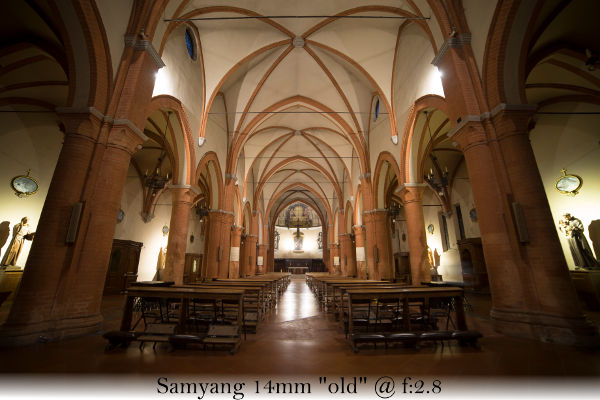 | 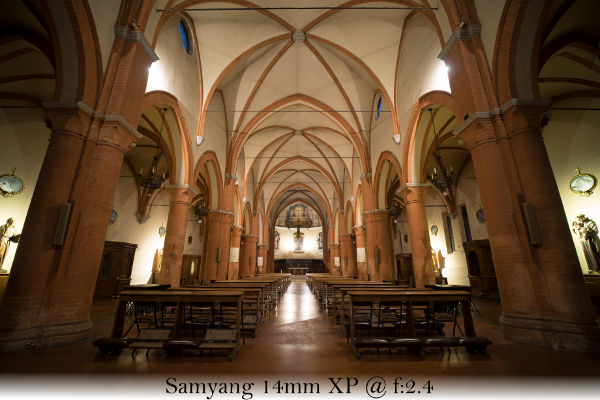 | 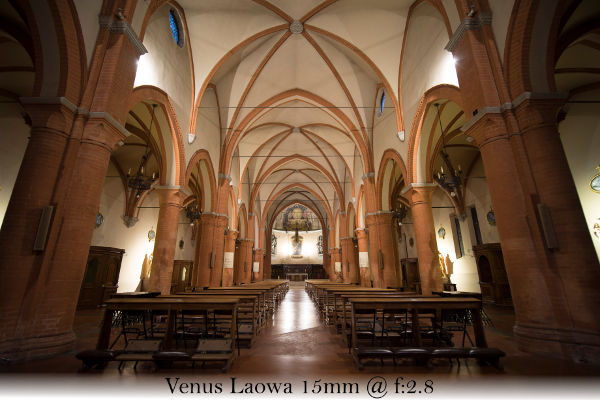 |
As you can immediately see, there is a slight difference in the FoV of the lenses.... even between the 2 14mm Samyang lenses (the old one is also the wider one). Let's say that did not expect so much difference! ehehe
As a first overall look, the old Sammy is a bit more soft, while the other twos give the same feeling. Clean image, nice contrast. The Samyang versions are a bit warmer, probably, but the white balance was in auto mode. Let's zoom in 100%, on the focus area (the first bench on the left):
Samyang 14mm "OLD" 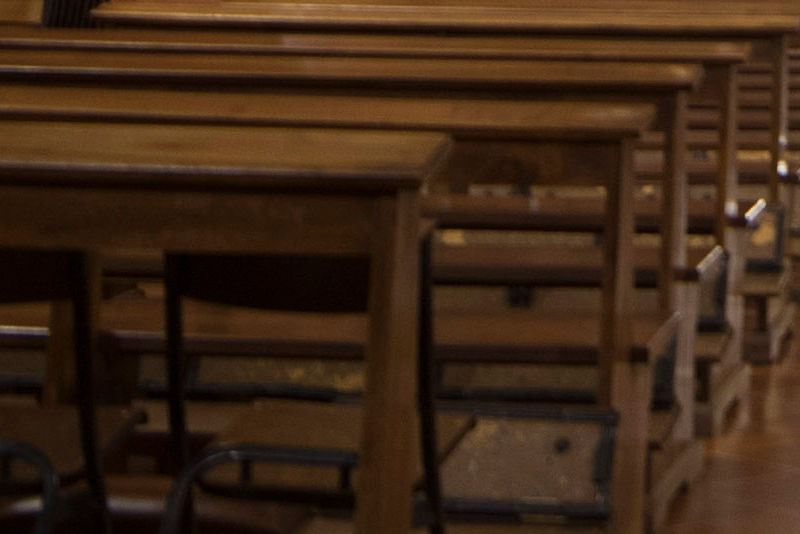 | Samyang 14mm XP 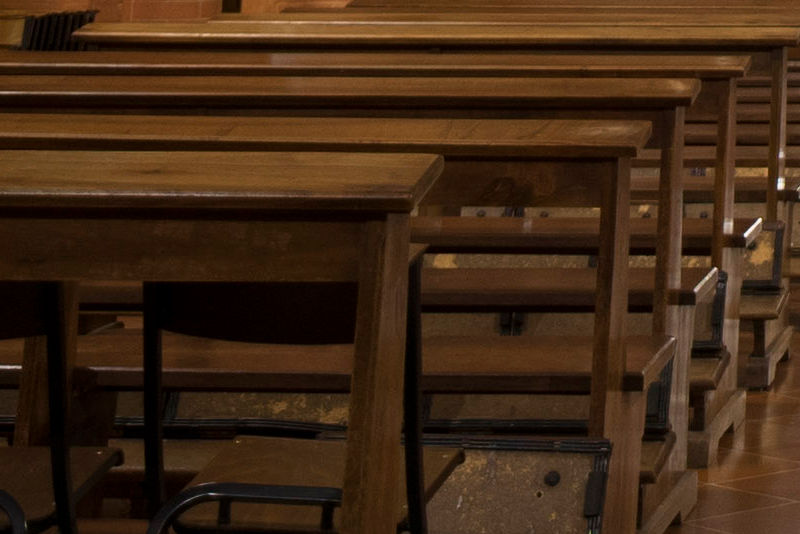 | Venus Laowa 15mm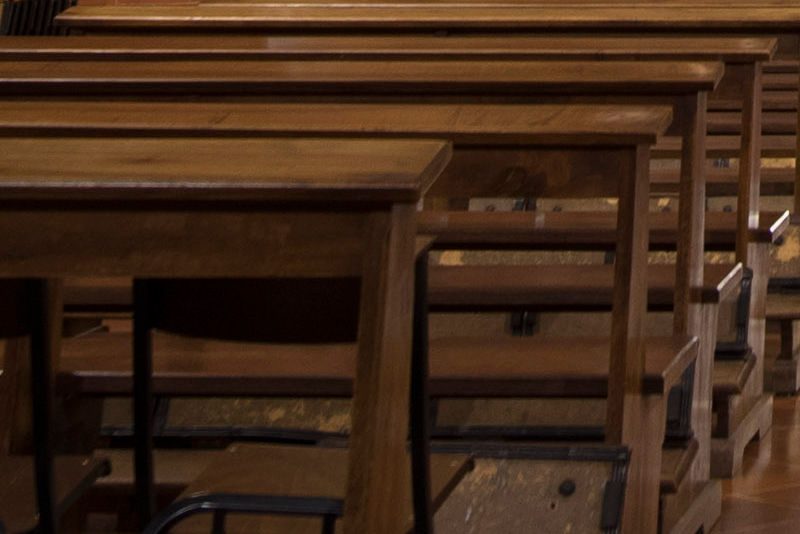 |
Here the difference is impressive! The Samyang XP 14mm outperforms the competitors in a terrific way! No doubt, at 2.4 it is way way sharper than the Venus Laowa (remember, the Laowa images was taken at f:2.8!). Even the contrast seems a bit better, but very little. I repeat myself: it is really a pixel peeper observation, but in this case the Samyang XP 14mm does exactly what they are stating on the website: this lens is perfect for 50MP sensors.
At the same time, we can see how the old Samyang 14mm f:2.8 is softer, compared to the others.
Let's see the same comparison, with shots taken at f:8 (that should be a sort of sweet spot for many lenses).
Samyang 14mm "OLD" f8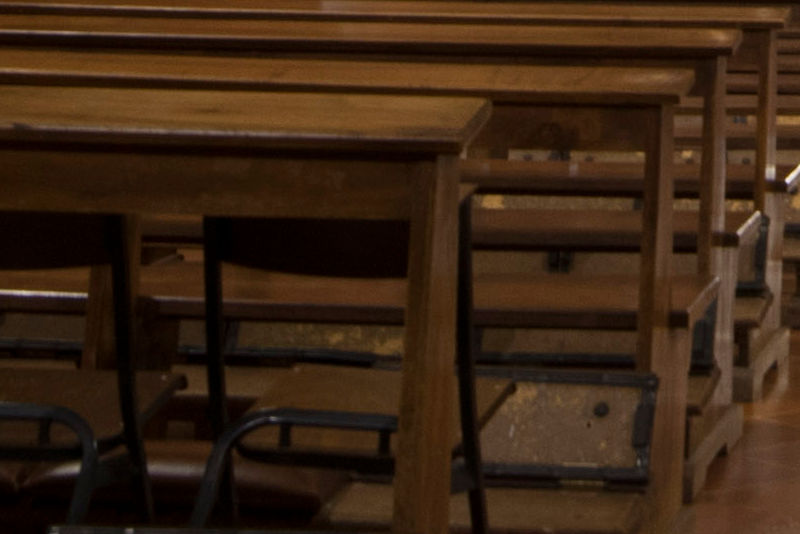 | Samyang 14mm XP f8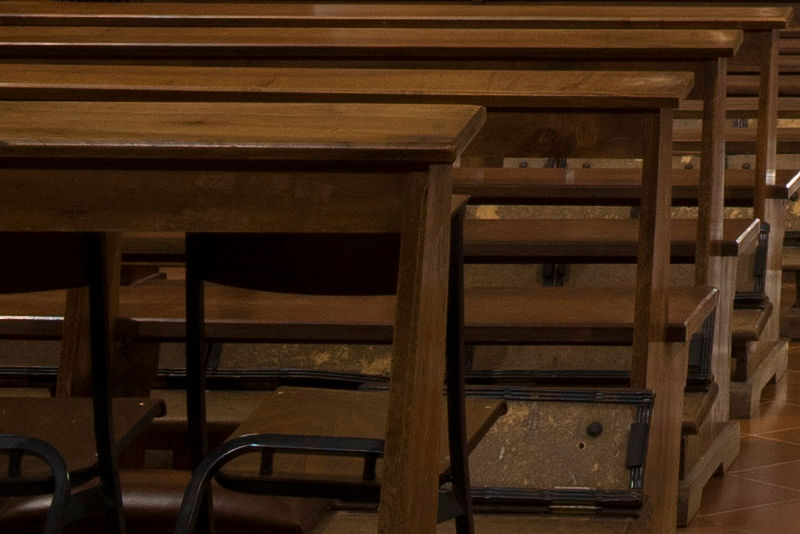 | Venus Laowa 15mm f8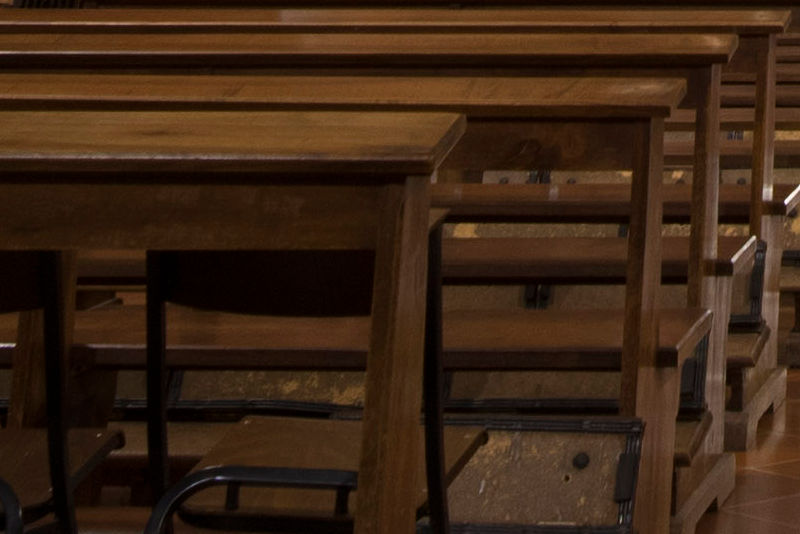 |
Even shooting at f:8, the Samyang 14mm XP is sharper than the Venus. The difference between the two of course is not so big, but it is still clear which one is the best.
Result: the Samyang 14mm XP outperforms the Venus Laowa 15mm; this is true both at f:2.4 and at f:8
Distortion
This is an important factor to be considered: both in landscape and in night photography it is very important to have a lens with little distortion. First of all, to get a "realistic" image, with a pleasant feeling. This can be solved in post production, of course, but loosing quality, and a lot of time.
Second, because distortion can cause great problems when we want to stitch together different shots to create a panorama. In fact, the softwares for pano stitching work not so well at the boundaries (where distortion creates the biggest differences); you do have to pay a lot of attention in shooting with little or no vertical tilting. And keep subject not too close to the camera.
Ok, let's see the two images:
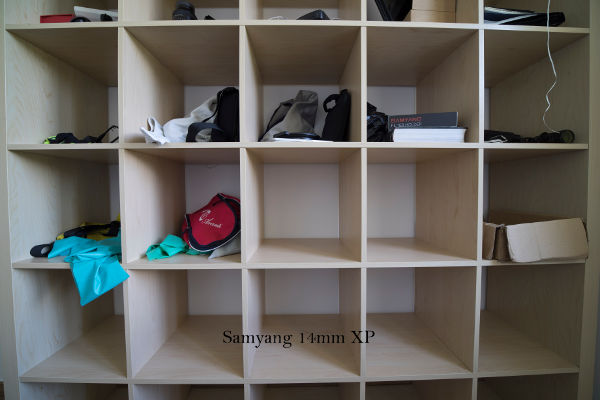 | 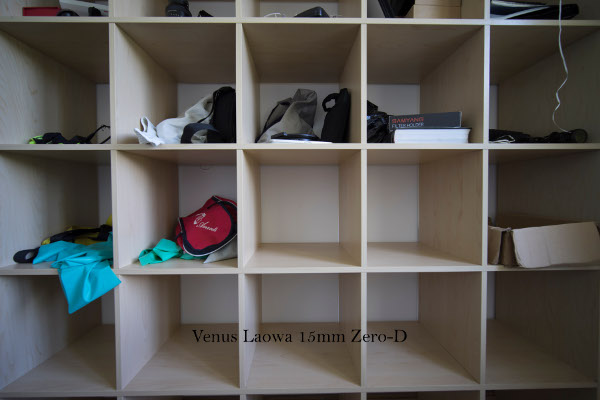 |
As you can easily see, as expected the Samyang 14mm has a distortion greater than the Venus Laowa 15mm. Of course the angle of view is not equal, but it is very easily seen.
Even if I didn't take the shot perfectly, it is clear that straight lines are not straight anymore, and this is typical of barrel distortion. In the end of the article, you will see some shots taken with all three lenses, so you will be able to compare the two Samyang 14mm and the Venus Laowa 15mm.
Result: The Venus Laowa perform really better than the Sammy XP; even if it is important to say that the Sammy has anyway little distortion.
Coma
As I told, I had the Samyang 14mm XP for a limited amount of time, during which I had no chance to go for a night session. But I managed to get one shot from my home yard.
The two shots below are taken at full aperture, that is the typical situation I adopt for night shots. In the next days I will take some more shots with Venus to see if something changes stepping down a bit... but for the moment this is all I have. For the same reason (using real life conditions), you will also see that the two shots are not equally exposed (the Venus one is a bit brighter, of course). ISO100, 25s, full aperture.
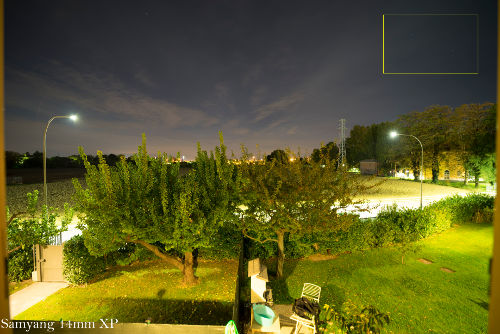 | 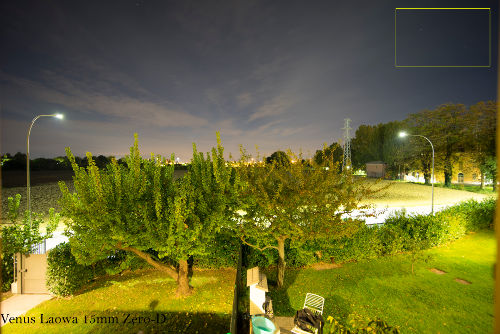 |
First, I apologize again for the poor shot: this is the best I was able to do in a very short time. From the image we can immediately see 2 things: the difference in exposure is quite noticeable (so the aperture difference is very important!), and in the Samyang shot there is a disturbing flare on the left side of the left street lamp. You can click on the images to get a full resolution jpg file.
Below a crop of the yellow area:
Samyang 14mm XP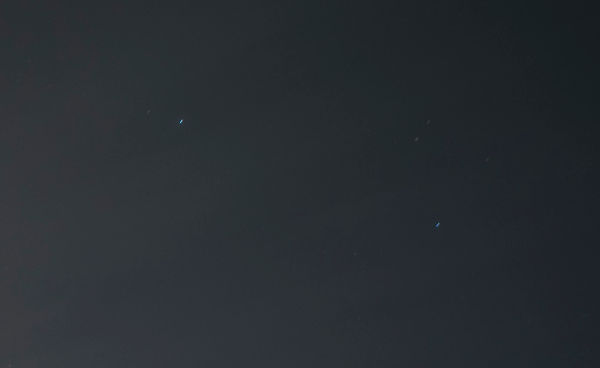 | Venus Laowa 15mm Zero-D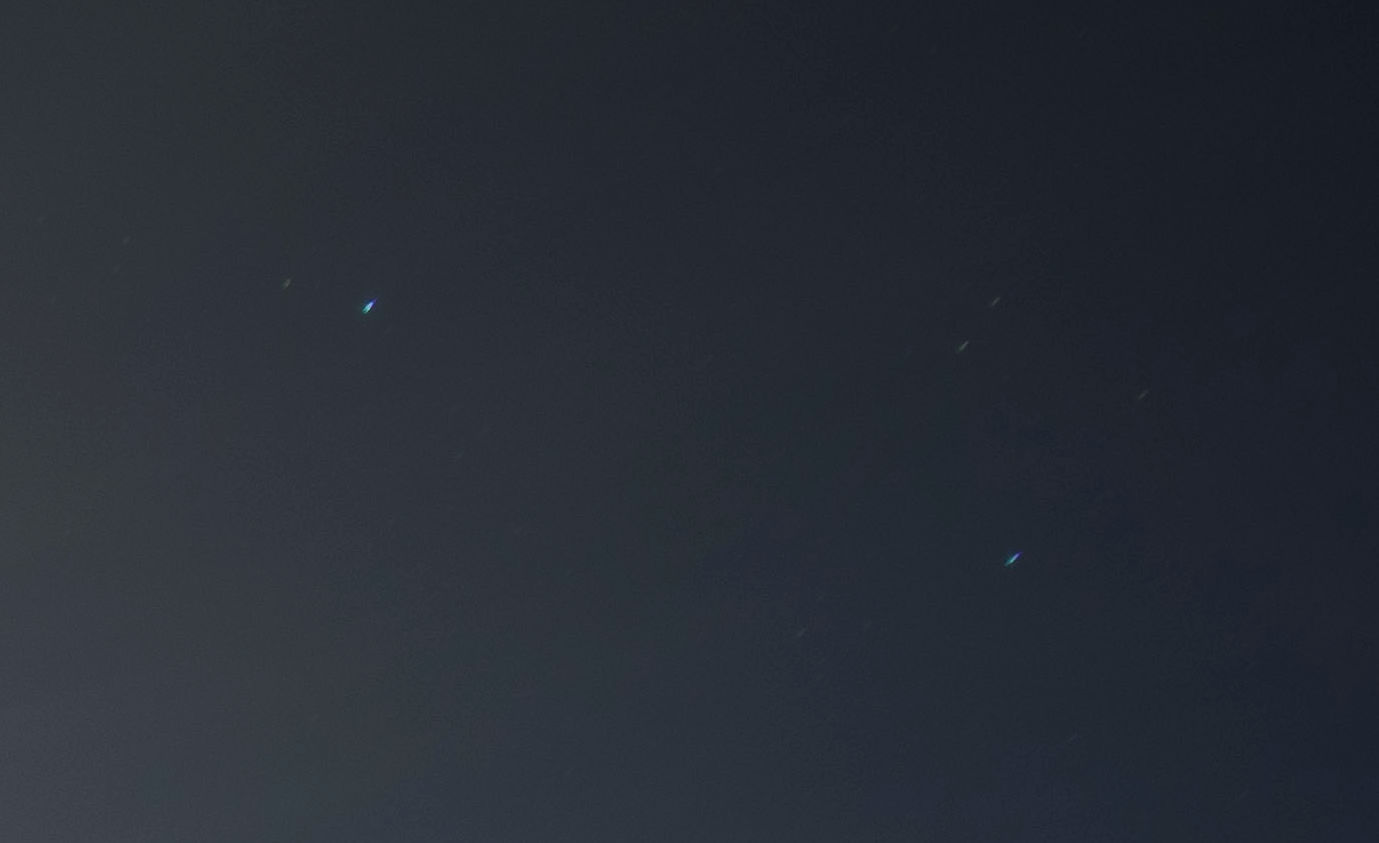 |
First, it is possible to see that the rule of 500 is not working so well with the Sony a7R sensor: the stars are not pins at all, and there is a noticeable star trail. This is acceptable for my standards, but it is important to mention.
Second, and more important, it is possible to see that Samyang XP has a lower coma. Surely the star dimensions are affected by the different focal length (even if it is a single millimeter, according to the NPF rule there is at least 1 second of difference!), but zooming in shows that Venus Laowa has a bit bigger coma.
Result: The Sammy XP seems to be a bit better; more tests should be performed, pairing the exposure using the NPF rule
Overall Quality and feeling
In my opinion, numbers and facts are really important if we want to judge and compare two piece of gear. Nevertheless we have to keep in mind two things:
- first, we are speaking about really high quality lenses. Doesn't matter which numerically performs better, we are speaking about lenses that are far above the standards.
- second, it is not always correct to judge things by numbers only... especially when we speak about photography (that I really consider a form of art).
Let's start from something we saw in the previous shots: the Venus Laowa showed a better flare resistance than the Sammy XP. I had no chance to test against direct sun light, but the results of the coma tests shows a noticeable flare in the Samyang XP shots, and no flare with the Venus 15mm Zero-D.
Speaking about vignetting, both the lenses show a bit of vignetting (quite normal for UWA lenses). I didn't have numerical data, but from the coma shots and the ones from the church, Venus Laowa seems to be a little bit better.
Conclusions
Let me say one more time that we are speaking about two great lenses. And once more I would like to say thank to Samyang Italia and Giordano Innovation for the kindness.
Samyang 14mm XP is the sharpest lens I've ever tested: even at f:2.4 the images are tack sharp and clean. The Venus Laowa,has a better flares resistance, and zero distortion.
A funny thing is about coma: even if I was not able to perform deeper tests, seems that the old Samyang 14mm f:2.8 shows the lowest coma. Exactly: a 300 bucks lens seems to be better than the other two high-end (and expensive) UWA. I will do some more tests in the next days...
So.. do you really have to sell your cheap Sammy, for a new UWA lens? and if yes... which one should you choose? The answer, in my opinion, is once agait "it depends": first, for 90% of the photographers out there (that show their work mainly on social media and seldom print in normal sizes) the good ol' Samyang 14mm f:2.8 is still a good choice. It only depends on how much you plan to use filters...
If you are seriously into landscape photography, probably the Venus Laowa 15mm Zero-D is the best lens for you: it is not as sharp as the new Samyang XP, but has less distortion, more flare resistance and (the most important thing) permits to use circular and square 100x100 filters. An unbeatable plus for a lanscape photographer. It is important to mention that Haida produces a filter holder for both the Samyang models, but it is more expensive and requires 150x150mm filters. Of course... it depends on the camera that you use, because at the moment the Venus has FE mounts only!
If you are a "serious" astrophotographer, or if you do not use filters for your shots on a regular basis, probably the Samyang XP is the best for you. It is probably the most expensive and the biggest (and heaviest) one, but the sharpness is great, and the overall quality is very good. In my opinion it is really too big to be used on a mirrorless camera (of course you can, but the ergonomics is terrible), taking into account that you must use also an adapter ring.